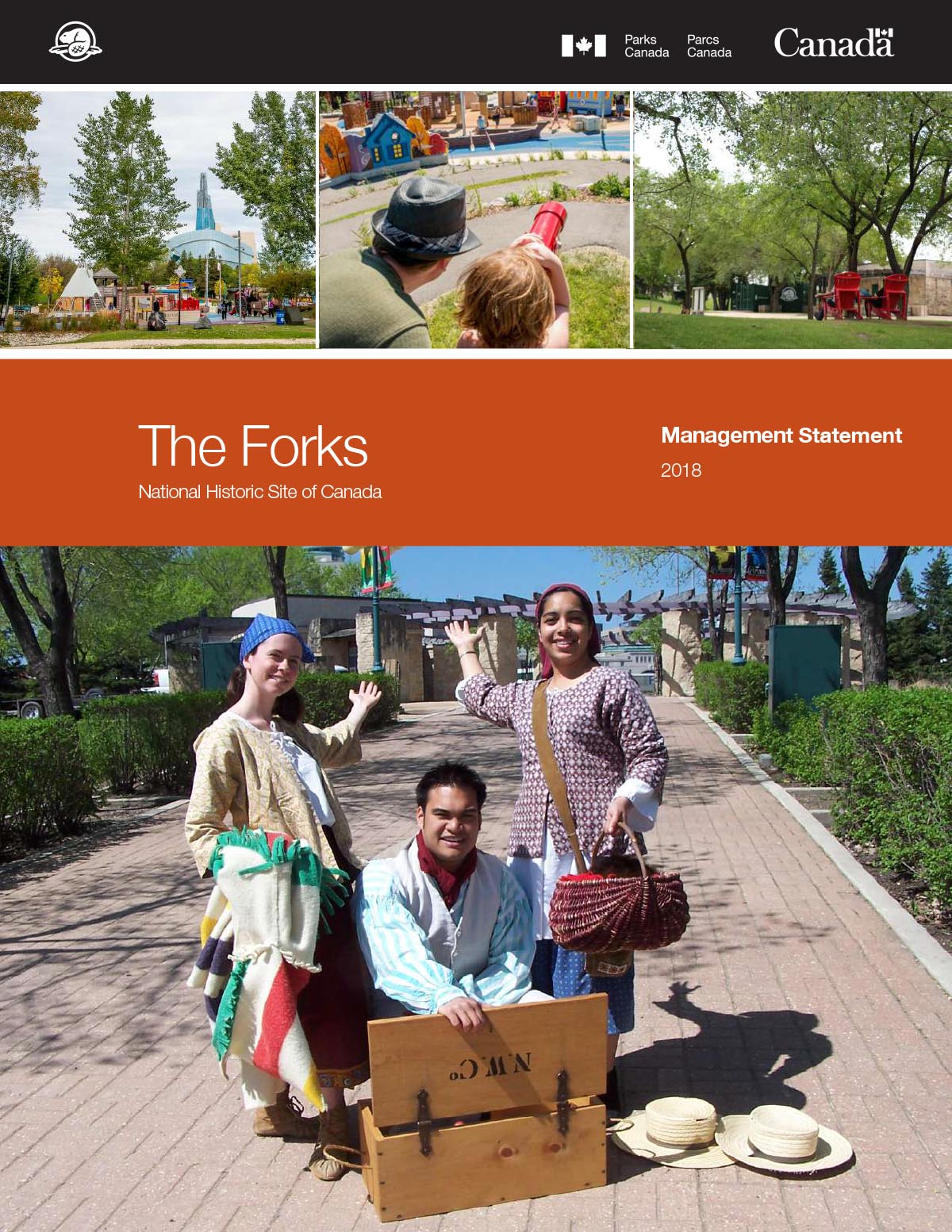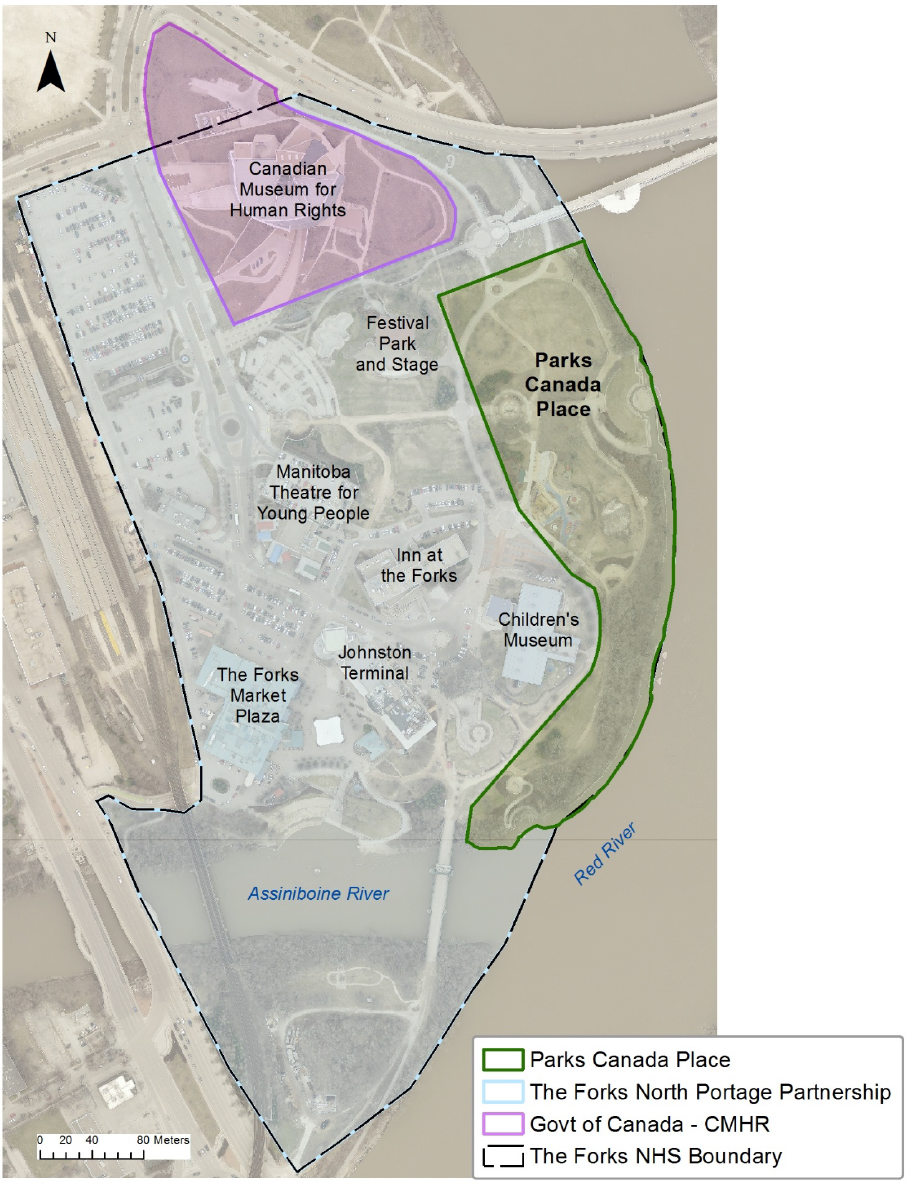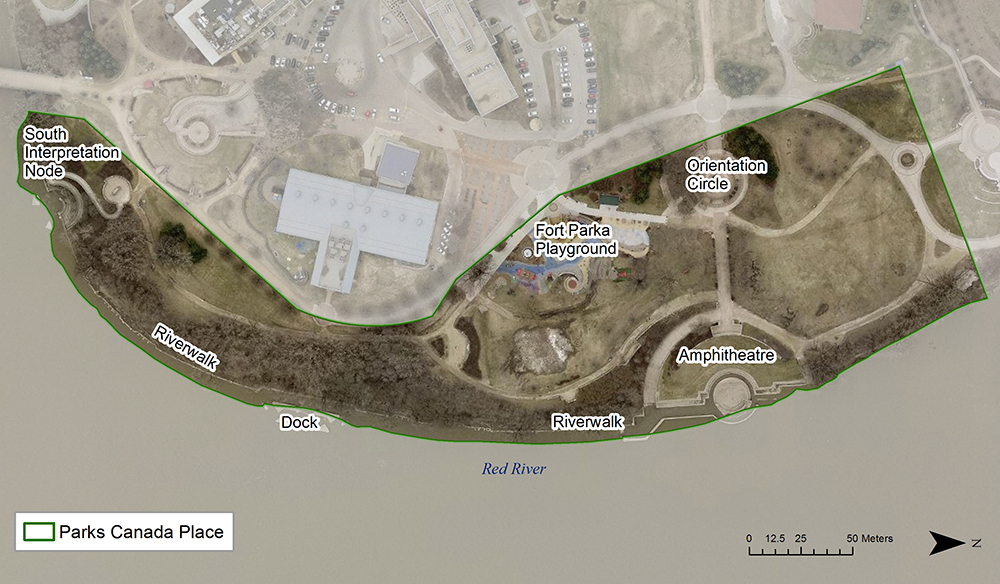The Forks National Historic Site of Canada Management Statement, 2018
The Forks National Historic Site
- PDF document: The Forks National Historic Site of Canada Management Statement, 2018 (PDF, 690 Kb)

© Her Majesty the Queen in Right of Canada, represented by the Chief Executive Officer of Parks Canada, 2018.
Cette publication est aussi disponible en français.
The Forks National Historic Site of Canada Management Statement 2018.
- ISBN R64-105/71-1-2018E-PDF
- Cat. no. 978-0-066-26490-5
For more information about the management statement or about The Forks National Historic Site of Canada
Winnipeg, MB R3B 0R9
Front cover image credits
Parks Canada
Foreword

Canada’s national parks, national historic sites and national marine conservation areas belong to all Canadians and offer truly Canadian experiences.
These special places make up one of the finest and most extensive systems of protected natural and cultural heritage areas in the world.
The Government is committed to preserving our natural and cultural heritage, expanding the system of protected places and contributing to the recovery of species-at-risk. At the same time, we must continue to offer new and innovative visitor and outreach programs and activities so that more Canadians can experience Parks Canada places and learn about our environment, history and culture.
This new management statement for The Forks National Historic Site of Canada supports this vision.
Management statements are developed through extensive consultation and input from various people and organizations, including Indigenous Peoples, local and regional residents, visitors and the dedicated team at Parks Canada.
National parks, national historic sites and national marine conservation areas are a priority for the Government of Canada.
I would like to thank everyone who contributed to this management statement for their commitment and spirit of co-operation.
As the Minister responsible for Parks Canada, I applaud this collaborative effort and I am pleased to approve The Forks National Historic Site of Canada Management Statement.
Recommendations
Recommended by and original signed by
Daniel Watson
Chief Executive Officer
Parks Canada
Trevor Swerdfager
Senior Vice-President, Operations
Parks Canada
Elvis Riou
A/Field Unit Superintendent, Manitoba Field Unit, Parks Canada
Introduction
The Parks Canada Agency manages one of the finest and most extensive systems of protected natural and historic areas in the world. The Agency’s mandate is to protect and present these places for the benefit and enjoyment of current and future generations. This management statement outlines Parks Canada’s management approach for the portion of The Forks National Historic Site, referred to in this document as Parks Canada Place, owned and administered by Parks Canada.
The Forks National Historic Site is located at the junction of the Red and Assiniboine Rivers in Winnipeg, Manitoba. It has witnessed many of the key events in western Canadian history, including thriving precontact Indigenous cultures, the fur trade, the exploration and settlement of Western Canada, the creation of the Province of Manitoba, and the establishment of the City of Winnipeg. The site lies within Treaty No. 1 territory, part of the traditional lands of many First Nations, and is the Birthplace of the Métis Nation and the Heart of the Métis Nation Homeland. The Forks National Historic Site is a public gathering place for recreational, commercial and educational use. It is a focal point for tourism in Winnipeg, receiving over four million visits a year.
The Forks National Historic Site in its entirety is co-owned and operated by Parks Canada, The Forks North Portage Partnership and The Canadian Museum for Human Rights (Figure 1). Parks Canada’s portion of the site, Parks Canada Place, is largely green space, 3.6 ha of the 25.3 ha of the designated site.
Visitor facilities and infrastructure at Parks Canada Place are minimal, including: an orientation node with public restrooms; interpretive signage; a playground with splash pad; a small open-air amphitheatre; a dock on the Red River; and a 382 m portion of the Winnipeg Riverwalk along the Red River (Figure 2). Frequent river floods render the Riverwalk, dock, and amphitheatre inoperable for portions of the year.
The cultural resources within Parks Canada Place consist of buried archaeological resources and viewscapes. Minimal site infrastructure and approximately one to two meters of fill, deposited during the railway era, ensures the continued legibility and well-being of the historic evidence that remains in situ. Parks Canada continues to review all projects and proposals for the site to minimize or mitigate potential impacts to cultural and natural resources.
Partnerships and working relationships with Treaty No. 1 First Nations, the Manitoba Métis Federation, tourism organizations, businesses, and not-for-profit organizations continue to play an important role in how Parks Canada manages Parks Canada Place. Collaboration with others enhances opportunities and allows Parks Canada to present heritage programs and offer other services in and around the site.
Management objectives
There are two opportunities that Parks Canada will pursue, expressed below as results-based objectives.
The presentation of First Nation and Métis culture is increased
The Forks area holds a special meaning for First Nations and the Métis. Parks Canada collaborates with Treaty No. 1 First Nations and the Manitoba Métis Federation so that their perspectives and knowledge are a part of site management, decision making, and programming.
- Parks Canada collaborates with Treaty No. 1 First Nations and the Manitoba Métis Federation for program and product development, interpretive content and visitor experiences to ensure that their history, stories and traditions are shared and celebrated at the site.
- The majority of First Nation and Métis programming is created and presented by members of those cultures who are aware of, and benefit from, economic and employment opportunities.
The visibility of Parks Canada Place at The Forks National Historic Site is increased through an enhanced visitor offer, services, and an identified presence on site
Parks Canada endeavours to incrementally increase the visibility and profile of Parks Canada Place within the greater Forks National Historic Site.
- Parks Canada has increased the visibility of Parks Canada Place through identifier signage and branding on site.
- A strategic review of site infrastructure identifies possible new investment or under-performing assets to allow Parks Canada effectively and sustainably meet its mandate.
- Contemporary, interactive paid programming which complements and competes favourably in the local and regional tourism market is provided by Parks Canada and third party partners.
Summary of strategic environmental assessment
Parks Canada is responsible for assessing and mitigating the impacts of management actions on ecosystems and on cultural resources. The Cabinet Directive on the Environmental Assessment of Policy, Plan and Program Proposals, prepared by the Canadian Environmental Assessment Agency, requires a Strategic Environmental Assessment of all plans and policies submitted to the federal Cabinet or to a Minister for approval deemed to have important positive or negative environmental effects.
A strategic environmental assessment was conducted for The Forks National Historic Site Management Statement. The spatial scope of the strategic environmental assessment included areas within the boundary of The Forks National Historic Site, and the temporal scope was a period of ten years from the date of plan approval, at which time the management statement will be reviewed. The resources considered to be Valued Components are the cultural resource elements commemorated and protected by the historic place designation, the fortifications, the historic buildings, the archaeological sites and the west bank of the Red River. Visitor experience resources including the various facilities are also important resources considered in the assessment.
Increasing collaboration with Treaty No. 1 First Nations peoples and Metis citizens and increasing presentation of First Nation and Metis culture will have positive effects on relationships and enhance the cultural context of the site.
Increasing the visibility of Parks Canada Place at The Forks National Historic Site will have numerous beneficial effects including enhanced knowledge, understanding and appreciation of the site and Parks Canada’s role in preserving and presenting Canadian history and culture.
Project-level impact assessment will be able to mitigate any potential adverse impacts from individual projects resulting from this management statement.
If the appropriate mitigation measures are applied, there are no significant adverse environmental effects anticipated from implementation of the management statement. The overall environmental effects of the strategies, objectives and targets of the management statement are expected to be positive.
Figure 1: The Forks NHS Property Owners/Administrators. Parks Canada 2017.

Figure 2: Parks Canada Place Facilities at The Forks NHS. Parks Canada 2017.

Related links
- Date modified :